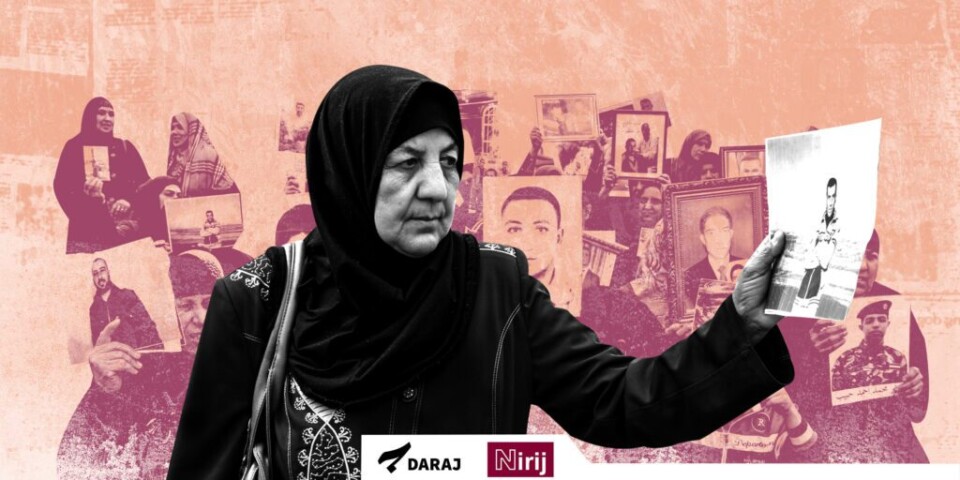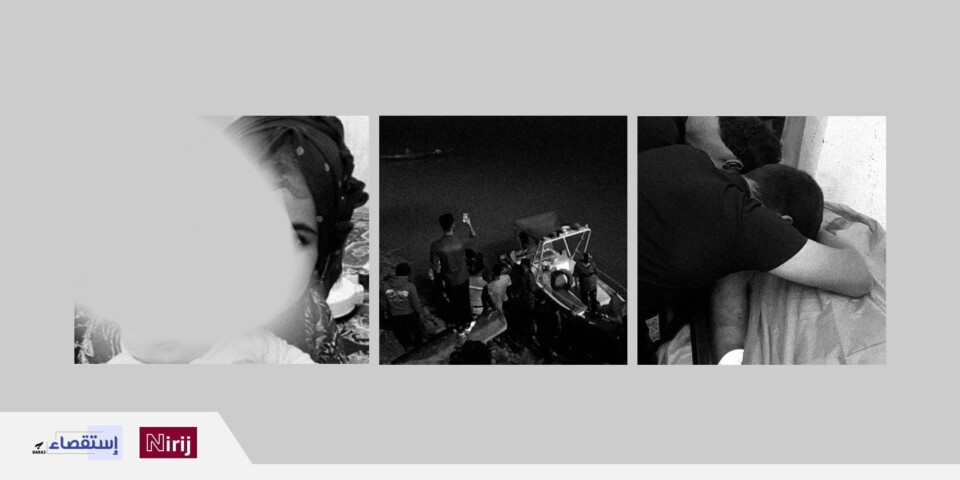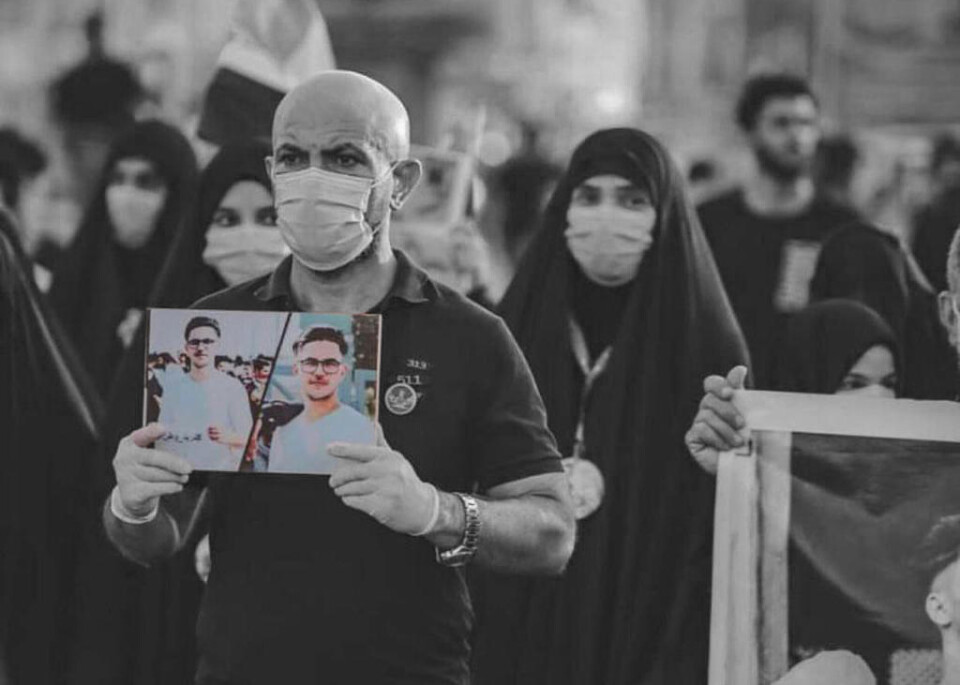

Ahmed Hasan, Translated by Walaa Rayya
On February 22, 2020, at around 8 p.m., the young protester “Muhammad Ali” (a pseudonym) was waiting alone near Kahramana square in central Baghdad, for a taxi to take him to New Baghdad in the south-east of the capital, where he will continue his way home on Palestine Street, but the vehicle he took moved him to another world that changed his life forever.
The cold and the darkness surrounded the place near the Chevrolet Car Company office, which is about several kilometers from Tahrir Square, the center of the popular protests when a white Kia car with four passengers in it stopped, they were unsuspicious. Muhammad slipped in it quickly as he exchanged greetings with them before silence prevailed.
A few minutes later, the car changed its way and was headed towards Abu Nawas Street on the Tigris River, when one of the passengers pointed his gun with a silencer placed under his jacket at Muhammad and said “Shut up if you want to live.” With these words, his kidnapping journey had begun and ended with a troubled life, isolation, paranoia, and great fear.
Muhammad (23 years) has been unemployed and was seeking work since graduating from the University of Baghdad’s Faculty of Political Science in the summer of 2019. Amid the wave of protests demanding reform in October 2019, he quickly became involved in supporting the protest movement and contributed to the establishment of the student sit-in tents on Saadoun Street leading to Tahrir Square. For months, he has worked passionately in fundraising to provide essential supplies of food, bedding, medicines, and face masks against deadly gas bombs.
“Hopes of ending corruption and reforming the political system were filling his soul before it all ended the moment he rode that white car that carried darkness into his world and turned his dreams into nightmares,” mentions one of his friends.
In early February 2020, after only four months of protests, the National Centre for Human Rights in Iraq reported the abduction of 72 people (22 of them was released.) , as well as 49 assassination attempts of 22 activists, journalists and bloggers. But the numbers escalated in the subsequent months.
Fadel al-Graoui, an OHCHR member, revealed, in early June 2021, what he termed the “numbers of missing persons,” and he said that all but 18 of the 76 disappeared persons have been identified.
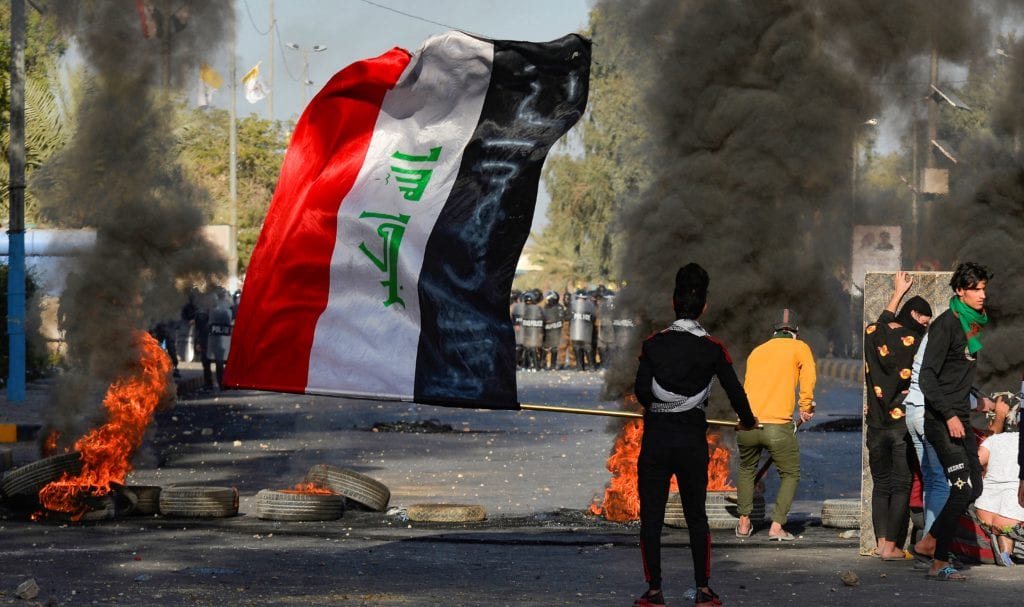
Death alleys
With successive crackdowns of repression along with arrests and kidnappings, activists preferred not to ride in a car in areas near Al Tahrir Square that were known as “death alleys” and were turned into sites for masked gunmen who made it a field of abduction and murder away from the eyes of security agents and protesters.
Abbas, a twenty years old brown man and Tuk-tuk car owner, who for months has been transporting protesters from the protest center “Al Tahrir “ to the Kahramana square, says: “It was a necessary step for protection against targeting in Al Tahrir square, but armed groups linked to the power parties, for which the demonstrations were considered a danger, began to kidnap activists from Kahramana after tracking them carefully.”
During November and December 2019, at least 103 attempted killings and abductions took place in the streets of Al-Saadoun, Al-Nidal, and Abu Nawas, according to the testimony of 10 groups’ leaders, as well as the testimony of security agents of the Establishment Protection Service, which is responsible for inspecting those entering Tahrir Square.
For almost a year, the protesters, who were thousands in Tahrir Square or gathering around it, used to watch the death and fall of their comrades with live bullets, gas canisters, and sniping weapons. According to government numbers, more than 560 people were killed and over 20,000 were injured.
Identical abduction tales
On the night that Muhammad was kidnapped, Abbas had taken him on his bike with two of his companions (Wael and Maysara). In Kahramana, the three friends broke up, and Muhammad was alone for minutes, using his cell phone and waiting for a car to pick him up. Armed groups would have preferred “to hunt activists alone to facilitate their kidnapping with no witnesses,” Abbas says.
A year after his kidnapping, in a small room in the family home, Muhammad agreed to receive us with his father and sister and several preconditions: “No cameras, no phones, no recording devices.”
The young man kept looking at us for minutes as he tried to figure out our intentions while his father was talking about the difficult days they lived through then he said: ” That night they took me to an abandoned orchard in the Dawra area south of Baghdad, just near the oil refinery. They acted quietly, pulled my phone, and they did not blindfold me to pass through security checkpoints normally. At one checkpoint, they said they were affiliated with the National Security Service.”
“On the way, they told me that they were from the demonstrations room and they wanted to verify the sources of the funds that I collected to support the demonstrations, but after passing the presidential brigade checkpoint, at the exit of the “AL Tabikayen” bridge overlooking the presidential district, and before passing a crossroads leading to “Al-Zaafaraniya” and “ the new Baghdad”, they entered a dirt road that included a checkpoint in which two agents in military clothes stood next to a Toyota pickup, on which the flag of the Popular Mobilization was raised. The barrier was rapidly removed and the car was allowed to pass. After a few minutes, that seemed to me very long I was immersed in thinking about the fate that expected me. We ended up in an orchard.”
Muhammad says: “When we got there, the kidnappers beat me, and one of them grabbed my shirt and pulled me out of the car hard and I fell to the ground. There were four people with beards waiting for me while they were carrying batons. I woke up late at night and found myself locked in a small, windowless room with a filthy bathroom. The room was completely isolated, and I didn’t know when it was morning or night. The hours passed by slowly, interspersed with brief sessions of repeated questions, insults, and physical torture committed by men in their late thirties, all dressed in yellow shirts and green pants.”

Death threat, ransom, and conditional release
After eight days and no news about him, the security services that Muhammad’s family contacted had the same answer “Your son is not detained by us.” Muhammad’s father, who works as a government employee, received a message from the kidnappers via the Telegram application asking him to sign a white paper to prevent his son from participating in student sit-ins and collecting donations in exchange for his release and to not disclose to anyone any information about what he was exposed to.
Several days later, Muhammad came out, after a complicated release mechanism, which included the intervention of a Shiite cleric who lives in the Zaafaraniyah area, and act as a mediator between the families of the victims and the kidnappers and he received thousands of dollars in each operation.
We looked at the messages exchanged between Muhammad’s father and the mediator, in addition to voice calls and photos of the kidnapper with signs of torture on all parts of his body up to his face. The mediator received five thousand dollars in two payments. “Thank God my son survived and returned, but he became introverted. For weeks after his return, he refused to meet his friends and even his brothers.” Muhammad’s father says.
The protests stopped, but the kidnappings didn’t
At the peak of the demonstrations between October 2019 and January 2020, hundreds of activists were subjected to arrest, kidnapping and torture, and these attempts continued after the protests declined and stopped in some areas with the formation of the new government. Jaafar al-Khasib (a pseudonym), is one of the Basra activists, who preferred to change his name to avoid tracking him. In October 2020, he fled to Sulaymaniyah in Kurdistan Province and went to Turkey after a kidnapping attempt in central Basra, where he nearly lost his life.
The activist tells us the details of the kidnapping attempt: “It was in mid-September 2020, on Algeria Street, minutes after I left the house and while I was passing near a parked white Toyota pickup, I was surprised by a loud sound from its engine, I turned and saw someone pointing his gun at me. I was standing in front of one of the shops. Scared and without thinking, I entered the place screaming and jostling with the employees in it, while the sound of gunfire went up.”
“I was lucky because the shop had a back door overlooking a public street that I came out of and I went to a garage next door. I begged people to help me, one of them directed me into the bathrooms, I stayed there for about a quarter of an hour, I was almost paralyzed, and I didn’t know what to do, the death was stalking me. They told me then that the gunmen had fled after one of the workers had been shot in the left leg.” The activist says.
The group that chased Al-Khasib was composed of three persons. They were planning to kidnap him, not kill him.
Hours after the incident, the local police inspected the place and the home of al-Khasib family and conducted a formal investigation after the owner of the shop reported the incident. The activist submitted his statement to the investigating officer who blamed him for his participation in organizing the demonstrations and held him responsible for what happened.
“He also said that my family was suffering because of me, and he told me clearly that the police could not protect me and it will best for me to leave Basra quickly. Then he whispered in my ear a name of a well-known figure in Basra who has been pursuing activists and protesters.” He explains.

Homicide for treason
Throughout the months of documenting the kidnappings, activists informed us that between September and October 2020, many of them received information about the “intentions” of a specific group to execute activists in the demonstrations and that they had “fatwas” legalizing the murder of “traitors” working for America, Britain and the Gulf countries.
In the same period, journalists received information from security parties close to the Prime Minister’s office, that there is a list of about 70 names of journalists and activists threatened with death by armed groups close to the parties in power. The charges are “communicating with countries hostile to the resistance factions”.
Security services, which were unable to protect protesters from armed factions, “believe that the protests are a conspiracy to threaten their existence.” It seems that they preferred not to be a partner in the crime, so they leaked the names of activists and journalists who are threatened with kidnapping or murder.”
This information was leaked days after four of Basra’s most prominent activists were subjected to assassination attempts, Reham Yaqoub (she was murdered on August 19) and “Tahseen al-Shahmani” (he was murdered on August 14), while both Ludia Raymond and Abbas Subhi managed to escape.
291 assassination attempts
The kidnappings and assassinations that took place after the “October Movement” 2019 were not limited to Baghdad and Basra, but also included nine provinces, according to a document that mentioned the names and dates of the assassinations and showed that most of the operations took place between four o’clock and eleven in the evening and were carried out with a variety of machine guns, including silencer weapons.
n officer in the National Security Service who was contacted several times before agreeing to meet with us in a cafe in central Baghdad, said, on the condition that he not be identified, that the assassinations took place based on “an organized action carried out by an armed group that was operating under the watchful eye of the Ministry of Interior and with the support of Shiite political parties.”
The document counted 291 attempted murders directly or after the abduction, as a result, 80 activists and demonstrators were dead, 122 others were injured, and 89 survived without injury, in Baghdad, Babylon, Karbala, Najaf, Diwaniya, Muthanna, Nasiriyah, Missan, and Basra.
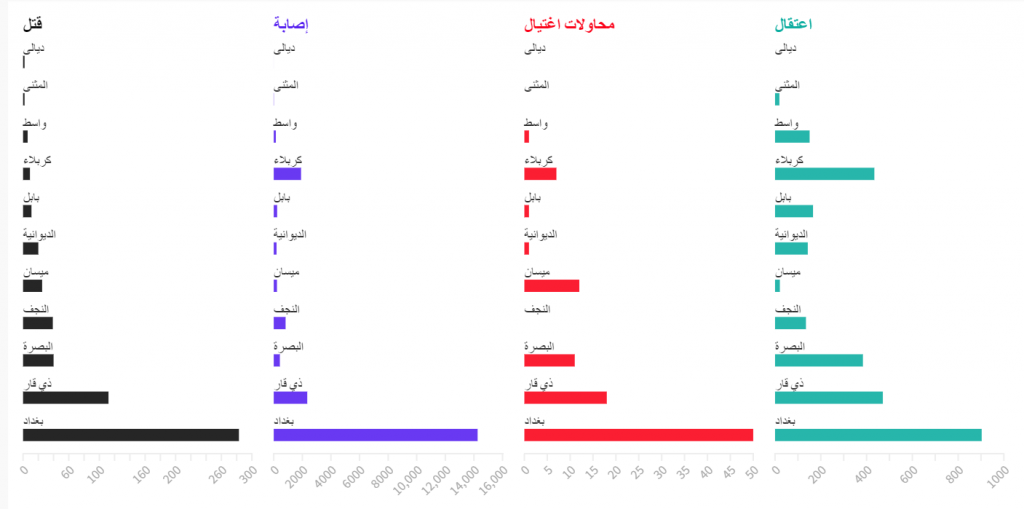
The special room
The officer reveals a “Protest Suppression Chamber” was formed under the chairmanship of Interior Minister Yassin Elyasri: “When the demonstrations intensified, they formed the Chamber to confront it, for them the demonstrations were an organized and funded operation to target the authority and the influential parties that have armed groups.”
He states further: “Its meetings included representatives of the Ministry of Defense, the Intelligence Service, officers in the National Security, the Popular Mobilization Forces, and influential actors of the partie.”
The officer in the National Security identified the party concerned with suppressing the demonstrators and prosecuting the activists: “We knew that there was a special operations room called the “Dealing with the Demonstrations” room. It seems that elements of it were planted within the riot police, and they were the ones who were throwing live bullets and tear gas bombs to kill and intimidate the demonstrators.”
This information intersects with statements by Yahya Rasoul, spokesman for the Commander-in-Chief of the Armed Forces, about the involvement of elements of the Ministry of the Interior (the Forces of Order and Riot Control), in using live bullets and tear gas to kill demonstrators. He accused the government of Adel Abdul Mahdi of these crimes.
Nasiriyah: From a protest center to a kidnapping square
For more than a year, Nasiriyah remained the center of the largest protests in southern Iraq. Kidnapping and assassination attempts were taking place in it to force the participants to withdraw from it.
Activist Ali Mehdi Ajil, who was subjected to two assassination attempts, the first one was on 28 November 2020, says “I was driving to the town police station in Nasiriyah to release the protesters who were arrested following clashes as a result of the burning of sit-in tents in Al – Habubi Square. On Prophet Ibrahim Street, I saw a large motorcycle following me with three hooded men on board. I quickly headed to the hall intersection. I knew the bike was chasing me.
A few days earlier, masked men on a motorbike fired three bullets, also on Nabi Ibrahim Street, one of which hit the windshield of his car.
Ajil, who survived the two attempts, ruled out the involvement of the Sadrist movement’s “Saraya Al-Salam” in the attempts. He believed that an armed political party affected by the demonstrations “sought to take advantage of the dispute between the demonstrators and Saraya Al-Salam and carried out a campaign of assassinations to sow discord and push the demonstrators to accuse the Sadrists who attacked the sit-in square and burned the tents after Al-Sadr called for an end to the sit-ins.”
The story of disappeared Sajjad
About months after the spread of the Coronavirus, which affected the momentum of the demonstrations, but did not end the sit-ins in Baghdad and Nazareth in particular, and the formation of the new government, the demonstrations ended.
On September 19, 2020, the young activist Sajjad Al-Iraqi was kidnapped in Nasiriyah, and his fate is still unknown.
Hajji Basem Falih, who was with the Iraqi during the kidnapping attempt and became a witness to the operation, said: “We were five persons in the car, heading to visit a friend who was injured in the protests. We discovered that two cars were chasing us, so we stopped. Four armed men wearing masks got out and asked us to remain silent and not move And they asked Sajjad to come down and go with them.”
In a quick quarrel that happened during the kidnapping attempt, the witness recognized one of the kidnappers by his voice, Idris Al-Ibrahimi.
According to Hajji Basem, Idris Al-Ibrahimi is an important figure who belongs to the Badr Organization led by Hadi Al-Amiri. He is a Dhi Qar Governorate resident and works as an employee of the Prisoners and Martyrs Foundation. He was formerly a prominent fighter in the Popular Mobilization Forces.
The witness called Idris Al-Ibrahimi for help, by his nickname: “Haji Abu Zahraa, please leave Sajjad.”
That did not work, and Ibrahimi became irritated and told the witness to remain silent, he broke the side window of the car with his pistol, while another gunman, who was carrying a pistol with a silencer, forcibly dragged Sajjad from the back seat and put him in the kidnappers’ car before returning and shooting Hajji Bassem because he identified Ibrahimi, but he miraculously survived after being transferred to Nasiriyah Hospital for treatment for a severe injury.
The incident sparked a wave of outrage among activists and forced the government to force the Counter-terrorism Service to search for Sajjad, to release him, and arrest the kidnappers after unsuccessful attempts to communicate with parties to which the kidnappers belong, but it completely failed and Sajjad remained disappeared, while the security services kept secret the identities of the kidnappers and the details of the operation.
Sajjad’s mother says that she knows the actors involved in the kidnapping of her son, and they are affiliated with an influential party: “There is no investigation. The case has been neglected and put on hold, so there is nothing new and the security services did not inform us of anything. Rather, we are the ones who provide them with information. The kidnappers names are recognized. Four witnesses have conclusive evidence that a person was involved in snitching on Sajjad and he has disappeared after the incident.”
Nine months after the incident and dozens of promises made to Sajjad’s mother by senior officials, the mother does not hide her despair of knowing the fate of her son, “I don’t know if he is dead or alive, nothing is more difficult than that.”

Endless wait
For nearly a year, activists have been waiting for the results of a fact-finding committee to uncover those involved in the killing and kidnapping of protesters, and the investigation committees that were formed after each operation did not identify the persons or parties involved. It’s an endless waiting to forget the causes, as activists see.
With the silence of the government, voices emerged among protesters pointing fingers directly at power parties and armed factions associated with the Popular Mobilization Forces. They note that factional media – specifically Kataeb Hezbollah and Asaeb Ahl Hak – shared statements, comments, and writings that attacked the protests and questioned activists’ motives, accusing them of employment, treason and receiving money from abroad.
Stalking Activists’ Families
Many activist homes have been attacked with firearms and sound packets, like the house of activist Hussein Al – Ghrabi in Dhi Qar, while other have received threatening messages through their phones or contact with their relatives.
Activist Ali Mahdi Ajeel confirms that the armed groups do not hesitate to do anything to stop the protests. “They hung a hanging and bloodied baby doll on the door of my house. It was a clear message that they know me, they know my house and the children, and they can kill anyone if I don’t withdraw.”
Malik al-Tayeb, whose brother, a prominent activist in Diwaniyah, Thaer al-Tayeb, was assassinated in mid-December 2019, says: “A while ago, while I was my car returning from work, near Al-Hussein Hospital, a motorcycle driven by a masked person followed me and he asked me to stop. He asked me to drop the lawsuit about revealing my brother’s killers because that’s a enormous risk to my life. He said his words and sped off. I tried tracking him down, but he went into the narrow alleyways and disappeared. ”
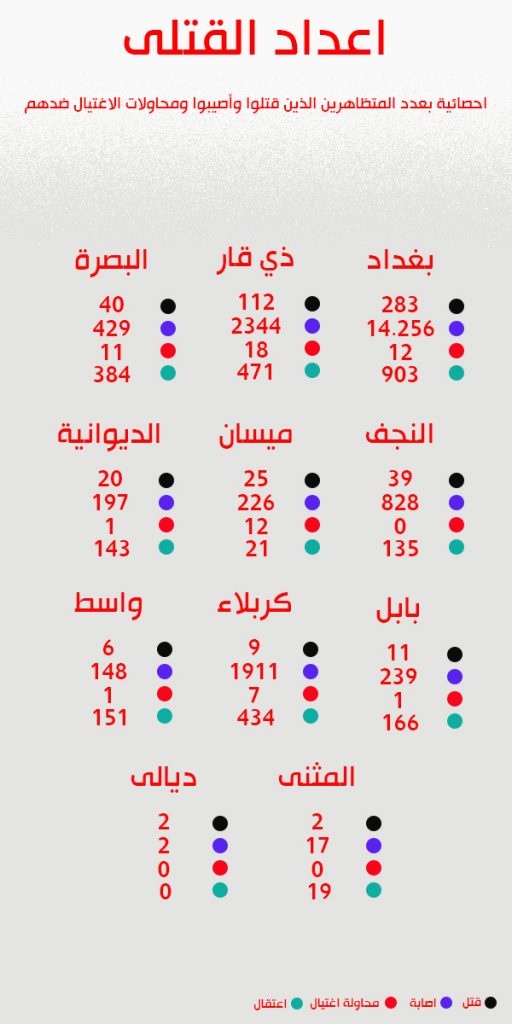
Will the killers be held accountable?
Even after the arrest of several members of the “death gang” in Basra accused of carrying out a series of killings, including the assassination of journalist Ahmed Abd Al-Samad and his colleague, the photographer Safa Ghali in January 2020, prominent activists question the accountability of those involved and believe that impunity will continue to prevail.
But a member of the Parliamentary Security and Defense Committee and representative of Basra, Bader Al-Ziyadi, shows some hope, and sees that the arrests of some members of the “death gang” as “a message of reassurance to the people of Basra that the security services can arrest the criminals, even after a while.”
He didn’t hide the fact that some security commanders requested to move the accused from Basra to Baghdad “so that there will be no pressure on the security services and no change of testimony under any internal influence or outside interference”.
Al-Ziyadi, who expressed his hope that the investigations will show “more and greater results about the motives behind these assassinations, and the nature of their members’ affiliations,” says that “the Parliamentary Security Committee will open the file and obtain accurate information from the security services to solve the murders”.
Yahya Rasoul asked to give chance to the intelligence effort to complete the investigations.
The head of the Supreme Judicial Council and Al-Kazemi’s office also rejected the claim of Adel Abdul-Mahdi’s government that there was a “third party” involved: “This is fake information and has nothing to do with the truth. There are two parties, the security forces, and the demonstrators.”
In November 2019, the former Defense Minister, Najah Al-Shammari, announced the presence of a third party accused of killing protesters.

“We are fighting a losing battle”
Under a powerless government that has been infiltrated by political groups with armed wings, Tishreen movement activists are almost unanimous in the impossibility of holding those involved in the kidnappings and assassinations accountable, and they doubt that the results will lead to effective detentions and trials and they mentioned the failure of the agencies to arrest suspects living in Iraq, and others will get out and this will be justified by the absence of evidence.
A renowned journalist in Basra, who refused to answer our questions many times, before accepting on condition that nothing indicating his identity be revealed: “We do not speak because we fear death, we do not trust the security services, they are infiltrated and helpless, and the militias have the final say. They arrested a few people here who are just tools while all the Basra agencies were unable to arrest the head of the group who was present in Basra. . And who says that these persons will be tried, there is pressure, and we may wake up one day and hear about their release due to insufficient evidence or their escape! We are in a losing battle.”
The despair over the possibility of achieving change through the elections and holding the perpetrators accountable pushed the “National House”, one of the forces emanating from the Tishreen movement, to announce its withdrawal, along with other Tishreen forces, from participating in the elections. Hussein Al-Ghurabi, one of the founders of “National House”, says: “It is useless under the government’s inability in front of the power of the militias and their weapons… How can I compete with them while they have all the cards in their hands?”
Abdul Qahar al-Samarrai, a member of Parliament, agrees with activists’ opinions on the government’s failure to identify the culprits: “Replacing Abdul-Mahdi’s government with this government was useless.”
He adds: “what the demonstrators were hoping for was not done by this government, so they are more resentful today than yesterday… and the forces that operate outside the state are increasing the street tension.”
He further states that “restoring confidence to the angry people comes from revealing the identities of the criminals, and this is a priority for the government, otherwise it will be described as its predecessors.”
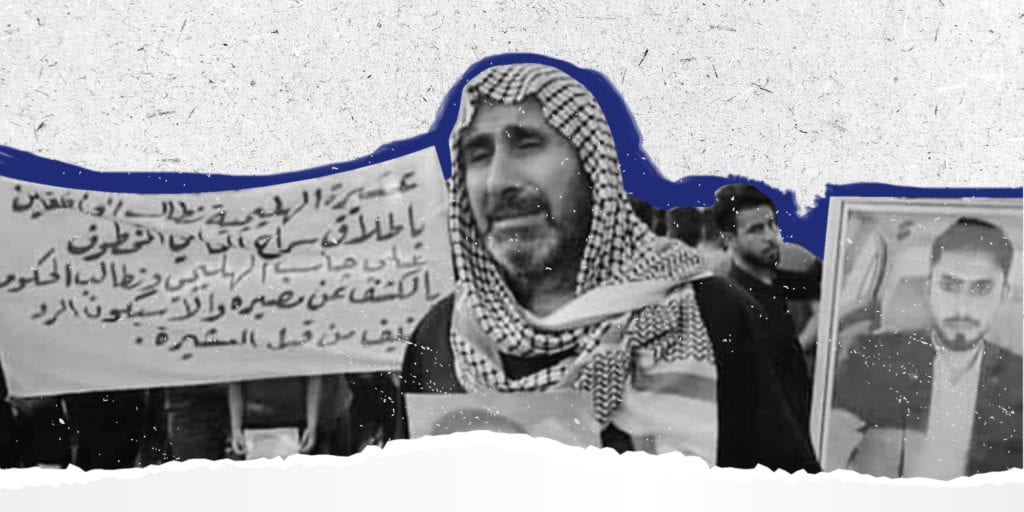
The disappeared son and the murdered father
On March 10, 2021, Jaseb Hattab Al-Heliji, father of the kidnapped lawyer Ali Jasp, was assassinated in the city of Amar, Missan province, hours after his participation in the commemoration ceremony of the murder of t Abdul Quddus Qassem, a prominent activist in Missan.
Jaseb is an old man known for his participation in the March protests and his activity on social media, after the kidnapping of his son, who was a lawyer and a civic activist, on October 8, 2019, in front of the Al Rawi Mosque in central Amara. Since then, he has been disappeared.
According to a relative of Jaseb, he was killed in Al-Amara, Al-Fiqa’i Al-Khaid, after he paid his respect to the Abd Al-Kuddus family.
Hours later, the police announced that they had arrested the culprit, “Hussein Abbas,” and that the motive was a clan dispute. Meanwhile, the Supreme Judicial Council reported that “the accused stated in his confessions that the victim (who is his uncle’s husband) was accusing him of kidnapping his son, which led to disputes and he filed a complaint against him. The pressures he was subjected to prompt him to kill the victim.”
However, the Jaseb family seemed unconvinced and demanded to reveal the identity of the entity who pushed the perpetrator to commit the murder and the one behind the abduction of their son Ali.
For about a year and a half, Jaseb has been trying to raise the disappearance issue, he participated in protests, raised a picture of his kidnapped son and his orphaned grandchildren, and demanded to reveal the fate of his son.
“Despite evidence in telephone calls and text messages, persons accused of kidnapping have been called as witnesses, not as defendants,” said Jaseb in a video.
Jaseb’s wait to know the fate of his gone son ended with his death, but his two grandchildren will grow up in a circle of waiting and revenge without a father or grandfather, while Sajjad’s mother will burn her remaining days between the pain of losing him and the hope of seeing him. She says: “I want to know his fate, whether he is alive or dead. His burial place. We do not deserve all this torment.”
Investigative Reports
Investigative Reports","field":"name"}],"number":"1","meta_query":[[]],"paged":1,"original_offset":0,"object_ids":21676}" data-page="1" data-max-pages="1">






